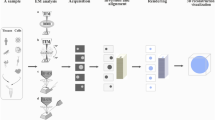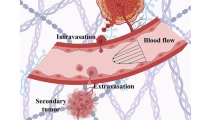Abstract
Cells establish and modulate their morphology and mechanics through the use of structural networks whose components range in size from a few nanometers to tens of micrometers. Over the past two decades, an exciting suite of sophisticated micro- and nanoscale technologies has emerged that permits investigators to directly probe structural and functional contributions of these components in living cells. Here we review underlying principles and recent applications of four such approaches: atomic force microscopy, subcellular laser ablation, micropatterning, and microfluidics. Together, these new tools are offering valuable insight into the molecular basis of cell structure and mechanics and revealing the remarkably broad influence of the mechanical microenvironment on many aspects of cell biology.







Similar content being viewed by others
References
McBeath R, Pirone DM, Nelson CM, Bahadiraju K, Chen CS (2004) Cell shape, cytoskeletal tension, and RhoA regulate stem cell lineage commitment. Dev Cell 6:483–495.
Engler AJ, Sen S, Sweeney HL, Discher DE (2006) Matrix elasticity directs stem cell lineage specification. Cell 126:677–689.
Hayakawa K, Tatsumi H, Sokabe M (2002) Mechanical stress in the actin cytoskeleton activates SA channels in the vicinity of focal adhesions in endothelial cells. Mol Biol Cell 13:340A.
Kasas S et al (2005) Superficial and deep changes of cellular mechanical properties following cytoskeleton disassembly. Cell Motil Cytoskelet 62:124–132.
Smith PG, Deng LH, Fredberg JJ, Maksym GN (2003) Mechanical strain increases cell stiffness through cytoskeletal filament reorganization. Am J Physiol Lung Cell Mol Physiol 285:L456–L463.
Puig-de-Morales M, Millet E, Fabry B, Navajas D, Wang N, Butler JP, Fredberg JJ (2004) Cytoskeletal mechanics in adherent human airway smooth muscle cells: probe specificity and scaling of protein-protein dynamics. Am J Physiol Cell Physiol 287:C643–C654.
Kumar S, Hoh JH (2001) Probing the machinery of intracellular trafficking with the atomic force microscope. Traffic 2:746–756.
Pesen D, Hoh JH (2005) Modes of remodeling in the cortical cytoskeleton of vascular endothelial cells. FEBS Lett 579:473–476.
Pesen D, Hoh JH (2005) Micromechanical architecture of the endothelial cell cortex. Biophys J 88:670–679.
Oberhauser AF, Badilla-Fernandez C, Carrion-Vasquez M, Fernandez JM (2002) The mechanical hierarchies of fibronectin observed with single-molecule AFM. J Mol Biol 319:433–447.
Bernheim-Groswasser A, Wiesner S, Golsteyn RM, Carlier MF, Sykes C (2002) The dynamics of actin-based motility depend on surface parameters. Nature 417:308–311.
Rotsch C, Jacobson K, Radmacher M (1999) Dimensional and mechanical dynamics of active and stable edges in motile fibroblasts investigated by using atomic force microscopy. Proc Natl Acad Sci U S A 96:921–926.
A-Hassan E, Heinz WF, Antonik MD, D’Costa NP, Nageswaran S, Schoenenberger CA, Hoh JH (1998) Relative microelastic mapping of living cells by atomic force microscopy. Biophys J 74:1564–1578.
Charras GT, Horton MA (2002) Single cell mechanotransduction and its modulation analyzed by atomic force microscope indentation. Biophys J 82:2970–2981.
Parekh SH, Chaudhuri O, Theriot JA, Fletcher DA (2005) Loading history determines the velocity of actin-network growth. Nat Cell Biol 7:1219–1223.
Chaudhuri O, Parekh SH, Fletcher DA (2007) Reversible stress softening of actin networks. Nature 445:295–298.
Prass M, Jacobson K, Mogilner A, Radmacher M (2006) Direct measurement of the lamellipodial protrusive force in a migrating cell. J Cell Biol 174:767–772.
Oliver T, Dembo M, Jacobson K (1999) Separation of propulsive and adhesive traction stresses in locomoting keratocytes. J Cell Biol 145:589–604.
Koonce MP, Strahs KR, Berns MW (1982) Repair of laser-severed stress fibers in myocardial non-muscle cells. Exp Cell Res 141:375–384.
Berns MW et al (1981) Laser microsurgery in cell and developmental biology. Science 213:505–513.
Strahs KR, Berns MW (1979) Laser microirradiation of stress fibers and intermediate filaments in non-muscle cells from cultured rat heart. Exp Cell Res 119:31–45.
Burt JM, Strahs KR, Berns MW (1979) Correlation of cell surface alterations with contractile response in laser microbeam irradiated myocardial cells. A scanning electron microscope study. Exp Cell Res 118:341–351.
Strahs KR, Burt JM, Berns MW (1978) Contractility changes in cultured cardiac cells following laser microirradiation of myofibrils and the cell surface. Exp Cell Res 113:75–83.
Heisterkamp A, Maxwell IZ, Mazur E, Underwood JM, Nickerson JA, Kumar S, Ingber DE (2005) Pulse energy dependence of subcellular dissection by femtosecond laser pulses. Opt Express 13:3690–3696.
Engler AJ, Griffin MA, Sen S, Bonnemann CG, Sweeney HL, Discher DE (2004) Myotubes differentiate optimally on substrates with tissue-like stiffness: pathological implications for soft or stiff microenvironments. J Cell Biol 166:877–887.
Paszek MJ et al (2005) Tensional homeostasis and the malignant phenotype. Cancer Cell 8:241–254.
Peyton SR, Putnam AJ (2005) Extracellular matrix rigidity governs smooth muscle cell rigidity in a biphasic fashion. J Cell Physiol 204:198–209.
Even-Ram S, Doyle AD, Conti MA, Matsumoto K, Adelstein RS, Yamada KM (2007) Myosin IIA regulates cell motility and actomyosin-microtubule crosstalk. Nat Cell Biol 9:299–309.
Peterson LJ, Rajfur Z, Maddox AS, Freel CD, Chen Y, Edlund M, Otey C, Burridge K (2004) Simultaneous stretching and contraction of stress fibers in vivo. Mol Biol Cell 15:3497–3508.
Sanger JW, Sanger JM (1979) The cytoskeleton and cell division. Methods Achiev Exp Pathol 8:110–142.
Kano Y, Katoh K, Fujiwara K (2000) Lateral zone of cell-cell adhesion as the major fluid shear stress-related signal transduction site. Circ Res 86:425–433.
Kumar S, Maxwell IZ, Heisterkamp A, Polte TR, Lele TP, Salanga M, Mazur E, Ingber DE (2006) Viscoelastic retraction of single living stress fibers and its impact on cell shape, cytoskeletal organization, and extracellular matrix mechanics. Biophys J 90:3762–3773.
Khodjakov A, La Terra S, Chang F (2004) Laser microsurgery in fission yeast; role of the mitotic spindle midzone in anaphase B. Curr Biol 14:1330–1340.
Tolic-Norrelykke IM, Sacconi L, Thon G, Pavone FS (2004) Positioning and elongation of the fission yeast spindle by microtubule-based pushing. Curr Biol 14:1181–1186.
Botvinick EL, Venugopalan V, Shah JV, Liaw LH, Berns MW (2004) Controlled ablation of microtubules using a picosecond laser. Biophys J 87:4203–4212.
Parker KK et al (2002) Directional control of lamellipodia extension by constraining cell shape and orienting cell tractional forces. FASEB J 16:1195–1204.
Lele TP, Pendse J, Kumar S, Salanga M, Karavitis J, Ingber DE (2006) Mechanical forces alter zyxin unbinding kinetics within focal adhesions of living cells. J Cell Physiol 207:187–194.
Nowotny M, Gummer AW (2006) Nanomechanics of the subtectorial space caused by electromechanics of cochlear outer hair cells. Proc Natl Acad Sci U S A 103:2120–2125.
Matthews BD, Overby DR, Mannix R, Ingber DE (2006) Cellular adaptation to mechanical stress: role of integrins, Rho, cytoskeletal tension and mechanosensitive ion channels. J Cell Sci 119:508–518.
Wang YX, Botvinick EL, Zhao YH, Berns MW, Usami S, Tsien RY, Chien S (2005) Visualizing the mechanical activation of Src. Nature 434:1040–1045.
Janmey PA, Weitz DA (2004) Dealing with mechanics: mechanisms of force transduction in cells. Trends Biochem Sci 29:364–370.
Suh KY, Kim YS, Lee HH (2001) Capillary force lithography. Adv Mater 13:1386–1389.
Kim YS, Park J, Lee HH (2002) Three-dimensional pattern transfer and nanolithography: modified soft molding. Appl Phys Lett 81:1011–1013.
Chou SY, Krauss PR, Renstrom PJ (1996) Imprint lithography with 25-nanometer resolution. Science 272:85–87.
Guo LJ (2004) Recent progress in nanoimprint technology and its applications. J Phys D Appl Phys 37:R123–R141.
McAlpine MC, Friedman RS, Lieber DM (2003) Nanoimprint lithography for hybrid plastic electronics. Nano Lett 3:443–445.
Thatcher RW, Gomez-Molina JF, Biver C, North D, Curtin R, Walker RW (2000) Two compartmental models of EEG coherence and MRI biophysics. Behav Brain Sci 23:412.
Singhvi R, Kumar A, Lopez GP, Stephanopoulos GN, Wang DI, Whitesides GM, Ingber DE (1994) Engineering cell shape and function. Science 264:696–698.
Bernard A, Renault JP, Michel B, Bosshard HR, Delamarche E (2000) Microcontact printing of proteins. Adv Mater 12:1067–1070.
Kim SO, Solak HH, Stoykovich MP, Ferrier NJ, de Pablo JJ, Nealey PF (2003) Epitaxial self-assembly of block copolymers on lithographically defined nanopatterned substrates. Nature 424:411–414.
LeDuc P, Ostuni E, Whitesides G, Ingber D (2002) Use of micropatterned adhesive surfaces for control of cell behavior. Methods Cell Biol 69:385–401.
Voldman J, Gray ML, Schmidt MA (1999) Microfabrication in biology and medicine. Annu Rev Biomed Engr 1:401–425.
Xia YN, Whitesides GM (1998) Soft lithography. Angew Chem Int Ed 37:551–575.
Whitesides GM, Ostuni E, Takayama S, Jiang XY, Ingber DE (2001) Soft lithography in biology and biochemistry. Annu Rev Biomed Engr 3:335–373.
Tan JL, Tien J, Pirone DM, Gray DS, Bhadriraju K, Chen CS (2003) Cells lying on a bed of microneedles: an approach to isolate mechanical force. Proc Natl Acad Sci U S A 100:1484–1489.
Wang N, Ostuni E, Whitesides GM Ingber DE (2002) Micropatterning tractional forces in living cells. Cell Motil Cytoskelet 52:97–106.
Kurpinski K, Chu J, Hashi C, Li S (2006) Anisotropic mechanosensing by mesenchymal stem cells. Proc Natl Acad Sci U S A 103:16095–16100.
Kenis PJ, Ismagilov RF, Whitesides GM (1999) Microfabrication inside capillaries using multiphase laminar flow patterning. Science 285:83–85.
Beebe DJ, Mensing GA Walker GM (2002) Physics and applications of microfluidics in biology. Annu Rev Biomed Engr 4:261–286.
Takayama S, Ostuni E, LeDuc P, Naruse K, Ingber DE, Whitesides GM (2003) Selective chemical treatment of cellular microdomains using multiple laminar streams. Chem Biol 10:123–130.
Takayama S, Ostuni E, LeDuc P, Naruse K, Ingber DE, Whitesides GM (2001) Subcellular positioning of small molecules. Nature 411:1016.
Jeon NL, Baskaran H, Dertinger SKW, Whitesides GM, Van de Water L, Toner M (2002) Neutrophil chemotaxis in linear and complex gradients of interleukin-8 formed in a microfabricated device. Nat Biotechnol 20:826–830.
Kuczenski B, LeDuc PR, Messner WC (2007) Pressure-driven spatiotemporal control of the laminar flow interface in a microfluidic network. Lab. Chip. 7:647–649.
Acknowledgement
S. K. acknowledges the generous support of the Arnold and Mabel Beckman Foundation and the University of California.
Author information
Authors and Affiliations
Corresponding author
Rights and permissions
About this article
Cite this article
Kumar, S., LeDuc, P.R. Dissecting the Molecular Basis of the Mechanics of Living Cells. Exp Mech 49, 11–23 (2009). https://doi.org/10.1007/s11340-007-9063-7
Received:
Accepted:
Published:
Issue Date:
DOI: https://doi.org/10.1007/s11340-007-9063-7




